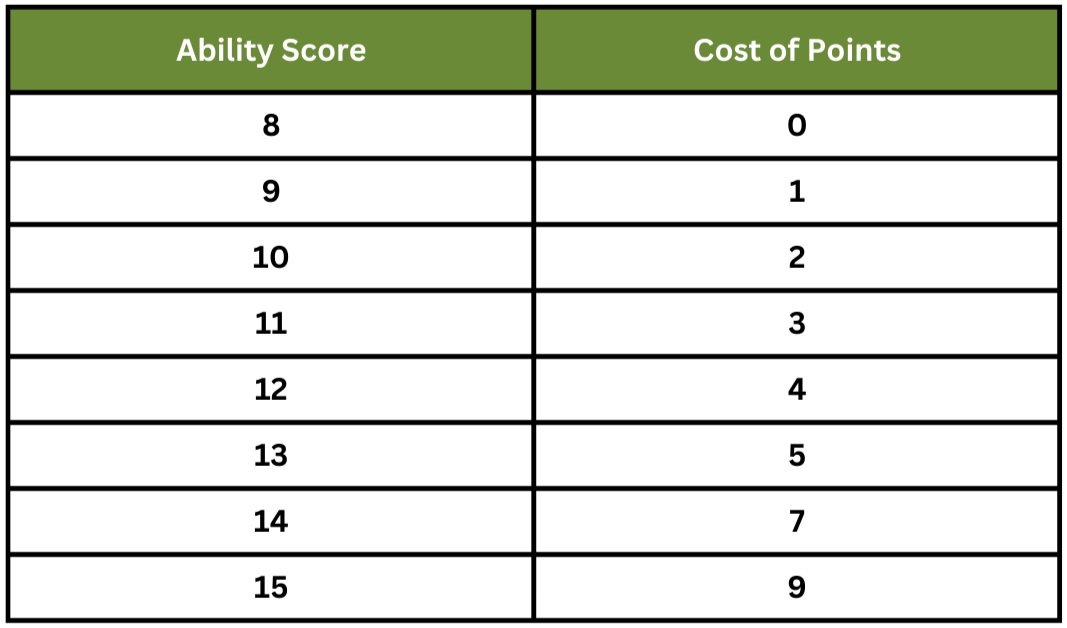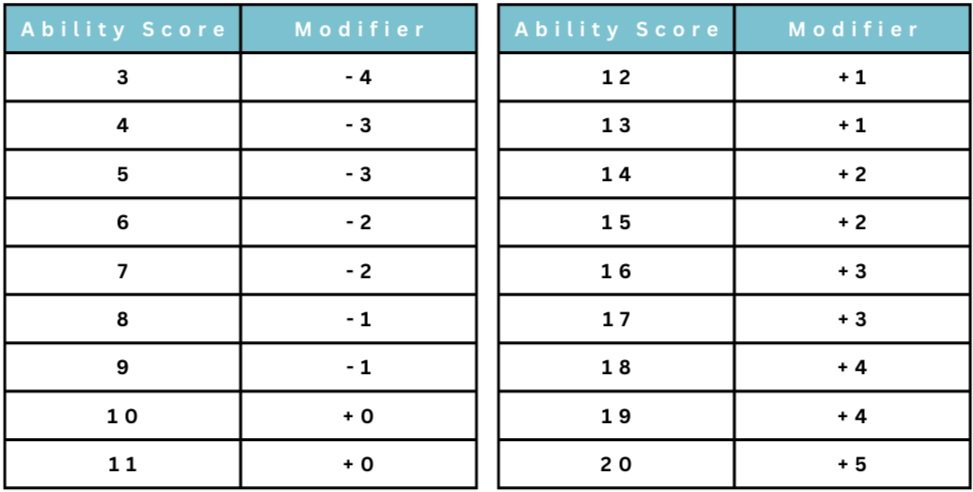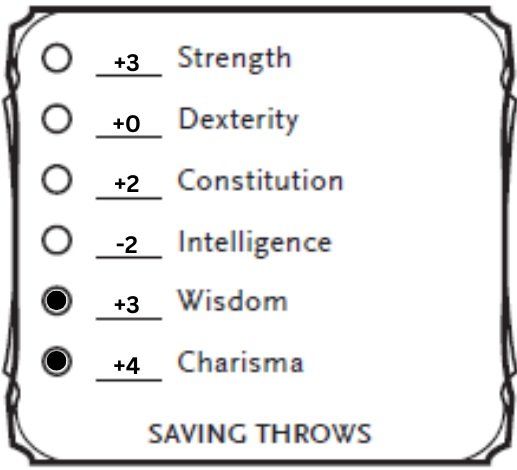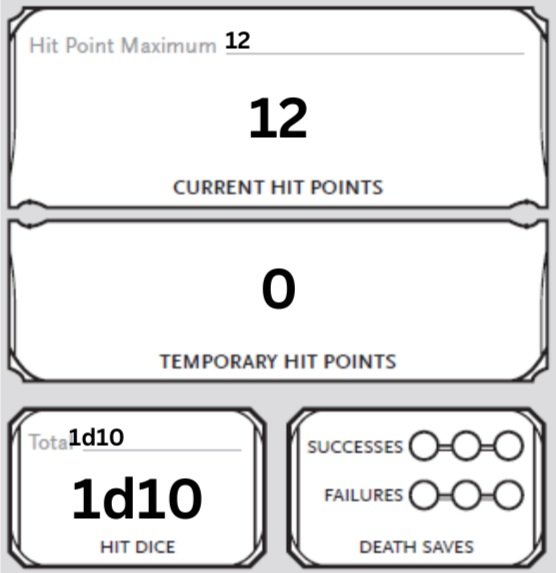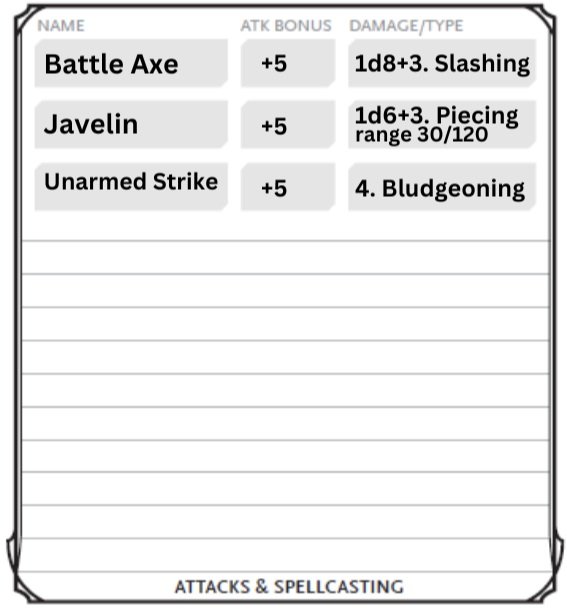How to Make a Dungeons and Dragons Character
The first step of starting an adventure is with an adventurer! I’m going to show you how to make a Dungeons and Dragons character for fifth edition, the 2014 version. There are some differences for 5e and 5.5e (the new rules added in 2024). Here I will only be using the original 2014 5e Players Handbook to make a level one character. I do highly recommend getting a copy of the handbook. All you need to play D&D is the book, pencil, paper, and some dice! To get started, get your hands on a free official character sheet or a journal! You can also use lined paper to get started, but boy is it a pain in the butt.
A little disclaimer: There are different ways to make a character like using online character creators, and different order of the steps. This guide is for at home games but it should still work for online ones too. This is how I make my characters, so the order may be unusual. I just think this is easier than just following the Player’s Handbook, it isn’t as clear as I’d like it.
Here is a video I made on how to make your character if you prefer a video format! Don’t mind me as I don’t make eye contact with the camera, oops!
Step 1: Choose your race
When choosing your race, consider your class or at least the style of character you want to play. If you want to be a melee class and hit stuff good with giant weapons, I’d recommend going with races that naturally have higher strength like half-orcs, dragonborns, and dwarves. If you decided you want to sling spells, consider your more magically adept races like elves, half elves, and gnomes. Of course, this is a fantasy world and you can play however you like. Just be aware that the dice may not be in your favor if you choose a gnome barbarian.
Also, consider the world you will be in. If you already have a group and a DM ready to play, maybe they already have a list of races that makes sense for their world. Maybe dragonborns are extinct or perhaps elves are so rare it would change how that world views you.
There are 9 races to consider in the Players Handbook (yes, there are many more options in additional books and homebrew varieties, but I’m only looking at the basics for this guide)
Dwarf - Known for their resilience and stubbornness. 4-5ft tall. Lifespan is up to 350 years.
Elf - Known for their elegance and magical abilities. 5-6ft tall. Lifespan is up to 750 years.
Halfling - Known for being nimble and curious. 3ft tall. Lifespan is up to 150 years.
Human - Known for being well rounded and capable to adapt. 5-6ft tall. Lifespan is up to 100 years.
Dragonborn - Known for their pride and strength. 5-7ft tall. Lifespan is up to 80 years.
Gnomes - Known to be clever and mischievous. 3-4ft tall. Lifespan is up to 500 years.
Half-elf - Known to be wanders. 5-6ft tall. Lifespan is up to 180 years.
Half-orc - Known for their strength and family bonds. 5-6ft tall. Lifespan is up to 75 years.
Tiefling - Known to be charming and self-reliant. 5-6ft tall. Lifespan is up to 110 years.
The information is generalizations of each race and is only the average. Just like how most humans are 5-6 feet tall, there are of course a richer variety. There is a lot more information in the book on each race!
Step 2: Choose your Class
It is like choosing your career and what you want to specialize in, but often way more violent. If you are brand new to D&D I recommend choosing a simpler class for your first character, like fighter or barbarian. Spell casters are so fun to play but it gets overwhelming for a newcomer. But play whatever you want!
There are 12 classes in the Players Handbook to choose from
Barbarian - Fierce warriors capable of mass damage. Be strong, hit strong!
Bard - Creative magicians. An artist at grand performances and crafty magic.
Cleric - Priestly champions. Healing friends while wearing heavy armor and dealing damage.
Druid - Nature’s spellcasters. Shapeshift into animals, heal your allies, and use nature to cause destruction.
Fighter - Weaponry specialist. Fight well, fight smart.
Monk - Master martial artists. Hit fast and many times while moving quickly over any terrain.
Paladin - Holy warriors. Use your powerful smites to protect your oath and heal those in need.
Ranger - Nature’s warriors. Shooting arrows and shooting spells.
Rogue - Stealthy tricksters. Hide, strike, repeat.
Sorcerer - Inherent spellcasters. Gifted with wild magics.
Warlock - Bargained magic wielders. Slinging spells in their patron’s name and causing havoc.
Wizard - Scholarly spellcasters. So many books and spells, so little time!
Don’t forget to check out the subclasses your class may have. It can add a lot of flavor to your character!
Step 3: Choose your background
This is the general history of your character. What did they do before today? Your background decides which additional skills, and languages you learn and what starting equipment you receive. Choose one that fits best to what you have in mind to your character. Don’t worry if it doesn’t fit your backstory perfectly, you can always write your own lore for your character later!
In the player’s handbook, there are 13 different backgrounds to choose from:
Acolyte - religious servant
Charlatan - tricky socialite
Criminal - law breaker
Entertainer - preforming artist
Folklore Hero - legend of their hometown
Guild Artisan - skilled and well practiced in a craft
Hermit - lived mostly alone for years
Noble - a life of privilege and luxury
Outlander - grew up in the wilds
Sage - spent years studying
Sailor - traveler of the seas
Solder - trained in the military
Urchin - grew up poor and orphaned
Now, let us actually put letters on our character sheet! Write down your class, level (one), background, and race. Note down your own name and put “0” for experience points. We’ll talk about alignment later
Step 4: Ability scores and modifiers
These are a big deal! Determining your strength, dexterity, constitution, intelligence, wisdom, and charisma will effect just about everything. There are three different ways to get your base ability score numbers, which method is chosen by your DM. If you don’t know which one they prefer, I recommend using the standard array.
Rolling
Roll four d6 (six sided dice) and record the sum of the top three numbers. Example: I rolled a 5, 4, 1, and 5. I add the highest three numbers together and get 15.
Do this five more times. Example: After rolling six different times, my numbers are 15, 14, 7, 10, 10, and 11.
Standard Array
Your numbers are decided for you. You choose the base of your ability scores with the numbers: 15,14,13,12,10, and 8.
Point Buying
You have 27 points to “buy” the numbers you’ll use for your six ability scores. Example: Using the point buying method, I can get the scores 10,10,12,13,14 and 14.
Now, we have to determine which number goes where. This is best decided by your class. In the Player’s Handbook, under your chosen class, it tells you under “Quick Build” where to put your highest numbers. Bards want high charisma followed by dexterity, monks need high dexterity followed by wisdom, and so on. Remember to write everything in pencil, because these things do change. If you are a spell caster, you want your highest skill to be your spell casting ability and if you are a martial class you want to choose either strength of dexterity, depending on your style of fighting. Example: if I were making a paladin with the standard array, I would choose my strength to be 15, dexterity 10, constitution 13, intelligence 8, wisdom 12, and charisma 14.
We are not done yet! You add even more to these numbers, yay! Your race will add to your ability scores. Under your races traits, the Player Handbook tells you which ability score you increase. Make sure to also add any under your subrace too (if you have one)! Example, my paladin is a half-orc, so I’ll add 2 to my strength and 1 to my constitution. Making my ability scores now: strength 17, dexterity 10, constitution 14, intelligence 8, wisdom 12, and charisma 14.
Note: If your score is lower than 7 or higher than 18, there was likely a problem! Make sure you did your original math correctly! (with the rolling method, there is a way to roll 6,6,6,6 giving you 18 and 1,1,1,1 giving you 3. If you roll all ones, maybe ask you DM if they are chill with you rerolling that one!
Modifiers are the number you will add to a lot of different rolls like attacks and skills. These depend on what your ability modifiers are. At 10, your modifier is +0. For every two numbers above ten, you get a bonus: at 12 you have +1, at 14 you have +2, and so on. Any ability score under 10 receives -1 and goes down every two: at a 9 you are -1, at a 7 you are -2, and so on.
Once you have that all figured out, write it down! Fills good to fill in those big boxes!
Step 5: Proficiency Bonus and Saving Throws
If you are practiced at something, you are better at it! In D&D this is represented as your proficiency bonus. This will increase as you level up. To find your proficiency bonus, go to your class in the book. It will be in a handy table. At level one, your bonus will most likely be +2. Write it down!
Saving throws are how well you react to something. A character with high dexterity would be better at jumping out of a trap before it goes off, while someone with high condition is more likely able to handle food poisoning without a struggle, and someone with high charisma can handle an insult better than most. To see which saving throws you are proficient in, look under your class features. Fill in the little circles next to the saving throw(s) you are proficient in. Now add your ability score modifiers to each corresponding saving throw, making sure to also add your proficiency bonus to the one(s) you are good at!
Example: As a paladin, my character is proficient in wisdom and charisma saving throws. I made sure to add my +2 proficiency bonus to each of those scores on top of my ability modifiers.
Step 6: Skills
Your skills reflect how well your character can do particular things. A rogue is a sneaky guy, so he probably has a high stealth, a nimble monk likely has high acrobatics, a smart wizard certainty is well read and has a high history skill, and so on. Just like your saving throws, you will be proficient in some skills. To learn which skills you are proficient in, look at your background, and class features. Fill in the appropriate bubbles next to the skill name. Now, you might notice some letters to the right of your skill name like (dex), that tells you which ability score modifier to add to that skill! Go down the list and fill in your modifier for each skill and add your proficiency bonus where you filled in the bubbles.
Also fill out your passive perception. This is 10 + your perception skill.
Example: as a paladin with the noble background, I chose that my character is proficient in history, persuasion, athletics, and religion. My passive perception for this character will be 11.
Step 7: Hit Points
Hit points is how much damage your character can take before they hit the bucket. Hit dice is what you roll during a short rest to regain your health. You class determines what your hit dice is, so look under class features to find yours. Your hit point maximum is the biggest number of your hit dice plus your constitution modifier.
Keep your temporary hit points blank or at 0, during your adventure there are spells and goodies that you’ll add to your temporary hit points, making your health pool even bigger!
Keep you death saves blank as well. If your character hits 0hp (or lower) you fall unconscious and start to roll death saving throws. It is a stressful and exhilarating time!
Example: as a paladin, my hit dice is 1d10. Hit point maximum is 10 plus my con modifier of two, making it 12.
Step 8: Initiative and racial traits
Your character’s Initiative is how fast they can spring into action! Your Initiative is your dexterity modifier plus any magical items and feats you gain later in your adventure. Example: my paladin has a +0 to dexterity and wont have any magical items at level one, so her initiative is +0.
Your speed is determined by your race and will be found under race traits. Most characters have a speed of 30ft, gnomes and halflings are 25ft. This is how fast your guy can run per 6 seconds, more or less.
If you have darkvision, write it down in features and traits if your sheet doesn’t have a spot for it. This will also be under race traits. This is how far you can see in darkness. Humans like me and you can see diddly in complete darkness but elves and dwarves can see much better.
Some races come with inherent resistances. Dragonborns get are resistant to elements depending on their ancestry, dwarves are resistant to poising, and so on. Write down any resistances in features and traits if your sheet doesn’t have a conditions and resistances area.
It is time to write down some details about our characters! Write down any languages, proficiencies, features, and other important details under your race traits. Double check your subrace, if you have one, to grab all the info there! Gnomes get to tinker, elves don’t sleep, lightfoot halflings are naturally stealthy, and so on. Example: as a half-orc, my character has menacing, so I add proficiency to intimidation and need to change that in my skills. I’m writing down that she has relentless endurance, and savage attacks under my features and traits. Under languages, I list common and orc.
Step 9: Class and background proficiencies and features
Being proficient in equipment means you are used to using it and can use it effectively. If you would put my butt into some heavy armor and a battle axe, I sure wouldn’t be able to stand, let alone be any good in combat! However, my half-orc paladin would be great at that! Find what your character is proficient in under your class features and background details. Write down what your character is proficient in under proficiencies. Example: my paladin is proficient in all armor, shields, simple weapons, and martial weapons. Because she is a noble, she is also proficient in one type of gaming set.
Features, or feats, are cool things your character can do! Find your feats under your class. Barbarians rage, warlocks pick a patron, bards get bardic inspiration, and such. Example: my paladin has divine sense, and lay on hands. As I level up, I will get more cool feats.
Step 10: Equipment and Armor Class
Not to alarm you, but our characters have been naked this whole time! Let’s get some gear. To find what your character starts with, look up starting equipment in your class and background. Write these things down in your inventory. Example: my paladin starts with a bunch of stuff, here is what I chose: A battle axe, a shield, five javelins, an explorer’s pack, chain mail, and a holy symbol. With my noble background, she also gets a set of fine cloths, a signet ring, a scroll of pedigree, and 25gp.
Put some cloths on! Armor is the key factor to figuring out your AC, or armor class. This is how hard it is to hit you! In the book, find the armor you’ve been given as starting equipment. Find that AC and add your dexterity modifier (depending on the type of armor) and add any other bonus like a shield, magical item, or if you have a fancy feat that boosts it.
AC = armor rating + dexterity modifier (if applicable) + shield (if applicable) Example: My paladin is wearing chain mail so she wouldn’t add dexterity if she had any, and a shield. Her AC is 18.
Step 11: Attacks
Let’s dive into combat! Write down your weapons found in your inventory (as long as you are proficient in them) and maybe unarmed strike (we all have the power to punch!).
Your attack bonus is how good you are at hitting your target. To determine your attack bonus, add your proficiency bonus to either your strength or dexterity modifier. Use strength for melee weapons (unless they are finesse, then use your dex). Use dexterity for range weapons (unless they are thrown weapons like a hand axe).
Your damage is determined by the weapon. Write down what you would roll, which is found in the Players Handbook in equipment, and add either your strength or dexterity modifier again. Take note of what damage type your weapon deals. This is important to some enemies. Hitting a skeleton with a club does better than arrows because they be bone.
The attack bonus for an unarmed strike is your proficiency bonus + your strength modifier. The damage of each strike equals 1 + your character’s strength modifier. If your strength modifier is negative, your unamred strike does 0 damage and isn’t worth writing down. These numbers will be different if you have a feat that makes your punches better, like a monk!
Range is how far away you can hit stuff. For melee weapons, like a sword, your range is 5ft. If you have a reach weapon, that would be different. If you are using a range weapon, like a bow or throwing a weapon, you may notice some numbers. Rang spells and range weapons have 2 range labels, normal/long. Past the normal range attacks have disadvantage, and after the long range the attack cannot hit. Range attacks have disadvantage if they are within 5ft of a hostile creature who can see you and who isn’t incapacitated. Example: a shortbow’s range is 80/320, so if an enemy is 6-80ft away, you can attack normally but if an enemy is 81-320ft away, you attack with disadvantage and after 320ft you can hit it at all.
I will say that I think this is where the official character sheet suffers. There is not enough space for much here and it doesn’t address range. And how it the heck are we supposed to add spells here too?! Crazy.
In The Character Journals, I made lots of room to add more than three attacks, and added range.
Step 12: Spells
I love playing with magic! If you don’t have any spells, go ahead and skip this part. I’m going to start with spellcasting ability, spell attack bonus and spell save dc.
Your spellcasting ability is said in your class. Bards, warlocks, sorcerers, and paladins use charisma. Clerics, druids, and rangers use wisdom. Wizards use intelligence. However, some classes, like paladins and rangers, don’t get their spells until later levels.
Your spell attack bonus or modifier is how well you can hit stuff with a spell. Your spell attack bonus = your proficiency bonus + your spellcasting ability modifier.
Your spell save DC is how hard it is for others to resist your spells. Your spell save DC = 8 + your proficiency bonus + your spellcasting ability modifier.
Example: in creating a level one bard, my spell casting ability is charisma. My proficiency bonus is +2 and my charisma modifier is +3 so my spell attack bonus is +5. My spell save DC is 13.
Take note of how many spell slots you have. Cantrips you can cast all day, they don’t take any spell slots. Level one spells take more energy to cast and require a spell slot for each spell. These refresh every long rest, unless you have a special ability to regain spell slots like arcane recovery, sorcery points, or warlocks gaining them back after a short rest. Example: my level one bard only has 2 level one spell slots.
Now for my favorite part, picking out some spells! Find out how many cantrips and spells you learn at level one under your class features. Now go to page 207 of the Player’s Handbook to see the list of spells available to your class. (Note: some classes have a larger selection depending on your choices. Like druids of different circles get different spells, warlocks get different spells depending on their patron, and so on). Take your time here. Look up each spell to at least get a brief understanding of what they do. Example: my level one bard is going to choose mage hand and vicious mockery for his cantrips and charm person, cure wounds, feather fall, and thunderwave for his first level spells.
Make sure to prepare your spells. You can’t always have all spells ready to rock and roll at all times (unless you are a warlock or some other special case). This is essentially looking at your spellbook in the morning and reviewing which ones you think you will use for the day. Cantrips are always prepared. Some race and class features may give you different spells that are always prepared and don’t effect your number of prepared spells. The number of spells you hare prepared per day = spell casting ability modifier + level. Example: a level one druid with a wisdom modifier of +2 can prepare 3 spells a day, which is great because he only has two spells. However, he will learn a lot of spells when he levels up and then he will have to make harder decisions.
Step 13: Get to know your character
We know what your character is, what they can do, how much damage they deal, and what spells they know. But who are they? Why are they adventuring? Their motivations? Where are they from? I like to start by filling out their physical descriptions: age, height, eyes, etc. Most of these attributes are determined by their race, like gnomes are real short around 4ft and elves can be real tall at 6ft. Example: My half-orc is a tall, thicc young woman with brown eyes, light green skin, and black hair.
Alignment is a broad way to describe your character’s ethics. One identifies your characters morality (good, neutral, and evil) and the second is your character’s attitude (lawful, neutral, and chaotic). Example: My paladin orc values family, helping those in need and kindness, so she is good. She doesn’t care about the law or the written word, she will do whatever needs done by any means that is logical to her, so she is chaotic.
On to personality traits, ideals, bonds, and flaws. This helps flush out your character and understand them better. I recommend writing down a simple sentence of each. Under the background you chose, it will have recommendations to pick from or you can make up your own. Also, add any notes you may have about allies and organizations. If you are part of an artist guild, criminal network, or church, write it down! You can always add more stuff later.
I think it is a great idea to have a short backstory before you start to play. Don’t go into to much detail because some of those may change as you get familiar with your character and the world you are playing in. I ask myself the basics about my character: where and to whom where they born? What is their relationship to their family? How was childhood? Did they go to school? What is their employment history? What brings them to adventuring?
Step 14: The final step - name your character!
Breath life into your character by giving them a name. You might even already have a name for your adventurer! Names can come from anything. Check out my little guide on how to name your character here.
Congratulations, you officially have a Dungeons and Dragons character! Grab a free cheat sheet on your way out to your first adventure!
Thank you so much for using my guide! I worked hard to make it make sense. If you use my guide or have something to say about it, use #TheDicedApple anywhere! If I made an error, please send me an email at Apple@TheDicedApple.com
Happy adventuring,
Apple


